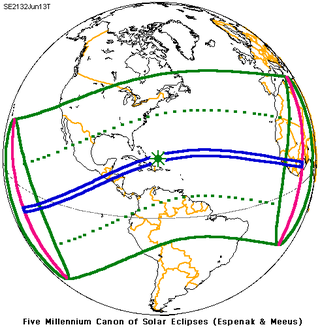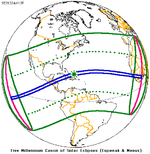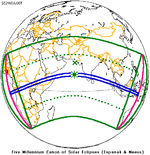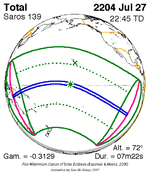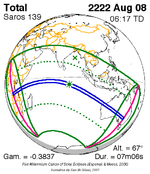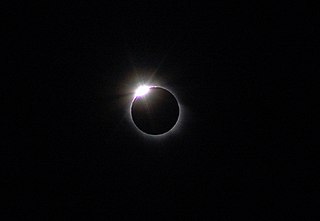
A total solar eclipse occurred on March 29, 2006. A solar eclipse occurs when the Moon passes between Earth and the Sun, thereby totally or partly obscuring the image of the Sun for a viewer on Earth. A total solar eclipse occurs when the Moon's apparent diameter is larger than the Sun's, blocking all direct sunlight, turning day into darkness. Totality occurs in a narrow path across Earth's surface, with the partial solar eclipse visible over a surrounding region thousands of kilometres wide. It was visible from a narrow corridor which traversed half the Earth. The magnitude, that is, the ratio between the apparent sizes of the Moon and that of the Sun, was 1.052, and it was part of Saros 139.
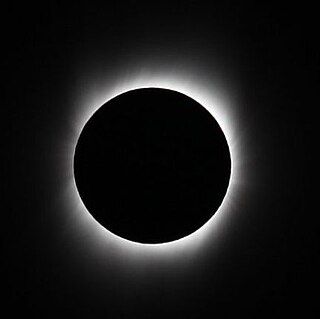
A total solar eclipse occurred at the Moon's descending node of the orbit on July 22, 2009 with a magnitude of 1.0799. It was the longest total solar eclipse during the 21st century, the longest total solar eclipse during the 3rd millennium will be on 16 July 2186. It lasted a maximum of 6 minutes and 38.86 seconds off the coast of Southeast Asia, causing tourist interest in eastern China, Pakistan, Japan, India, Nepal and Bangladesh. Its greatest magnitude was 1.07991, occurring only 6 hours, 18 minutes after perigee, with greatest eclipse totality lasting 6 minutes, 38.86 seconds during the Total Solar Eclipse of July 22, 2009.
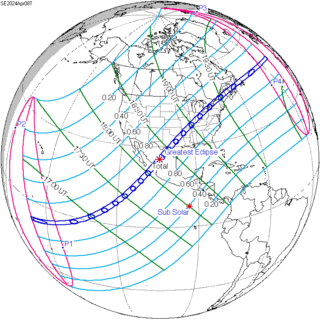
A total solar eclipse will take place at the Moon's ascending node of the orbit on April 8, 2024, visible across North America and dubbed the Great North American Eclipse by some of the media. A solar eclipse occurs when the Moon passes between Earth and the Sun, thereby obscuring the image of the Sun for a viewer on Earth. A total solar eclipse occurs when the Moon's apparent diameter is larger than the Sun's, blocking all direct sunlight, turning day into darkness. Totality occurs in a narrow path across Earth's surface, with the partial solar eclipse visible over a surrounding region thousands of kilometres wide.

A total solar eclipse will occur on April 20, 2042. A solar eclipse occurs when the Moon passes between Earth and the Sun, thereby totally or partly obscuring the image of the Sun for a viewer on Earth. A total solar eclipse occurs when the Moon's apparent diameter is larger than the Sun's, blocking all direct sunlight, turning day into darkness. Totality occurs in a narrow path across Earth's surface, with the partial solar eclipse visible over a surrounding region thousands of kilometres wide. It will be seen significantly in Western Indonesia, Eastern Malaysia, Brunei and the Philippines.
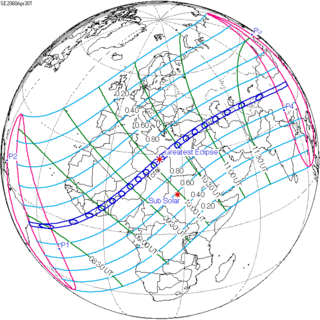
A total solar eclipse will occur on April 30, 2060. A solar eclipse occurs when the Moon passes between Earth and the Sun, thereby totally or partly obscuring the image of the Sun for a viewer on Earth. A total solar eclipse occurs when the Moon's apparent diameter is larger than the Sun's, blocking all direct sunlight, turning day into darkness. Totality occurs in a narrow path across Earth's surface, with the partial solar eclipse visible over a surrounding region thousands of kilometres wide.

A total solar eclipse will occur on May 11, 2078. A solar eclipse occurs when the Moon passes between Earth and the Sun, thereby totally or partly obscuring the image of the Sun for a viewer on Earth. A total solar eclipse occurs when the Moon's apparent diameter is larger than the Sun's, blocking all direct sunlight, turning day into darkness. Totality occurs in a narrow path across Earth's surface, with the partial solar eclipse visible over a surrounding region thousands of kilometres wide.

A total solar eclipse will occur on May 23, 2096. A solar eclipse occurs when the Moon passes between Earth and the Sun, thereby totally or partly obscuring the image of the Sun for a viewer on Earth. A total solar eclipse occurs when the Moon's apparent diameter is larger than the Sun's, blocking all direct sunlight, turning day into darkness. Totality occurs in a narrow path across Earth's surface, with the partial solar eclipse visible over a surrounding region thousands of kilometres wide. This will be the first eclipse of saros series 139 to exceed series 136 in length of totality. The length of totality for saros 139 is increasing, while that of Saros 136 is decreasing.
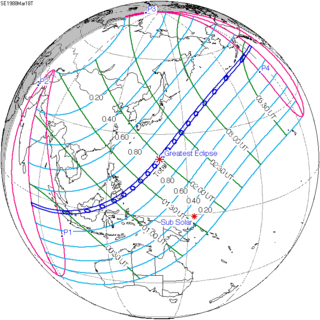
A total solar eclipse occurred on March 18, 1988. A solar eclipse occurs when the Moon passes between Earth and the Sun, thereby totally or partly obscuring the image of the Sun for a viewer on Earth. A total solar eclipse occurs when the Moon's apparent diameter is larger than the Sun's, blocking all direct sunlight, turning day into darkness. Totality occurs in a narrow path across Earth's surface, with the partial solar eclipse visible over a surrounding region thousands of kilometres wide. Totality was visible in Indonesia and southern Philippines.
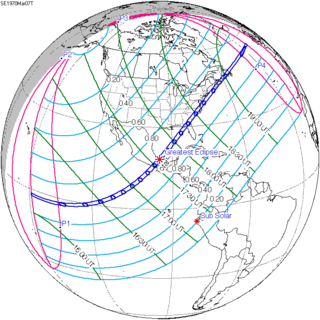
A total solar eclipse occurred on March 7, 1970, visible across most of North America and Central America.

A total solar eclipse occurred on February 25, 1952. A solar eclipse occurs when the Moon passes between Earth and the Sun, thereby totally or partly obscuring the image of the Sun for a viewer on Earth. A total solar eclipse occurs when the Moon's apparent diameter is larger than the Sun's, blocking all direct sunlight, turning day into darkness. Totality occurs in a narrow path across Earth's surface, with the partial solar eclipse visible over a surrounding region thousands of kilometres wide. The path of totality crossed Africa, the Middle East, and Asia.

A total solar eclipse occurred on February 14, 1934. A solar eclipse occurs when the Moon passes between Earth and the Sun, thereby totally or partly obscuring the image of the Sun for a viewer on Earth. A total solar eclipse occurs when the Moon's apparent diameter is larger than the Sun's, blocking all direct sunlight, turning day into darkness. Totality occurs in a narrow path across Earth's surface, with the partial solar eclipse visible over a surrounding region thousands of kilometres wide. Totality was visible from the Dutch East Indies, North Borneo, and South Pacific Mandate in Japan.

A total solar eclipse occurred on February 3, 1916. A solar eclipse occurs when the Moon passes between Earth and the Sun, thereby totally or partly obscuring the image of the Sun for a viewer on Earth. A total solar eclipse occurs when the Moon's apparent diameter is larger than the Sun's, blocking all direct sunlight, turning day into darkness. Totality occurs in a narrow path across Earth's surface, with the partial solar eclipse visible over a surrounding region thousands of kilometres wide. Totality was visible in Colombia, Venezuela, and the whole Guadeloupe except Marie-Galante, Saint Martin and Saint Barthélemy.

A total solar eclipse occurred at the Moon's ascending node of the orbit on March 29, 1987. It was a hybrid eclipse, with only a small portion of the central path as total, lasting a maximum of only 7.57 seconds. A solar eclipse occurs when the Moon passes between Earth and the Sun, thereby totally or partly obscuring the image of the Sun for a viewer on Earth. An annular solar eclipse occurs when the Moon's apparent diameter is smaller than the Sun's, blocking most of the Sun's light and causing the Sun to look like an annulus (ring). An annular eclipse appears as a partial eclipse over a region of the Earth thousands of kilometres wide. Totality of this eclipse was not visible on any land, while annularity was visible in southern Argentina, Gabon, Equatorial Guinea, Cameroon, Central African Republic, Sudan, Ethiopia, Djibouti and Somaliland.

A total solar eclipse will occur on July 16, 2186, which will be the longest total eclipse for thousands of years. The eclipse will pass over the southern Galápagos Islands, the northern tip of Ecuador, central Colombia, central Venezuela, and northern Guyana.
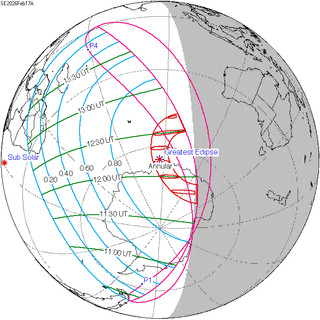
An annular solar eclipse will occur on February 17, 2026. A solar eclipse occurs when the Moon passes between Earth and the Sun, thereby totally or partly obscuring the image of the Sun for a viewer on Earth. An annular solar eclipse occurs when the Moon's apparent diameter is smaller than the Sun's, blocking most of the Sun's light and causing the Sun to look like an annulus (ring). An annular eclipse appears as a partial eclipse over a region of the Earth thousands of kilometres wide.

An annular solar eclipse occurred on December 14, 1955. A solar eclipse occurs when the Moon passes between Earth and the Sun, thereby totally or partly obscuring the image of the Sun for a viewer on Earth. An annular solar eclipse occurs when the Moon's apparent diameter is smaller than the Sun's, blocking most of the Sun's light and causing the Sun to look like an annulus (ring). An annular eclipse appears as a partial eclipse over a region of the Earth thousands of kilometres wide. Annularity was visible from French Equatorial Africa, Libya, Anglo-Egyptian Sudan including the capital city Khartoum, French Somaliland including the capital Djibouti City, British Somaliland including the capital city Hargeisa, the Trust Territory of Somaliland, the Maldives, Andaman and Nicobar Islands, Burma, Thailand including the capital city Bangkok, Cambodia, Laos, North Vietnam and South Vietnam, China, British Hong Kong, Taiwan, and Ryukyu Islands. It was the third central solar eclipse visible from Bangkok from 1948 to 1958, where it is rare for a large city to witness 4 central solar eclipses in just 9.945 years. This is the 20th member Solar Saros 141, and the last of first set of solar eclipses without a penumbral internal contact, the next event is the 1973 Dec 24 event, which is the first of 19 solar eclipses with a penumbral internal contact until 2298 Jul 09.
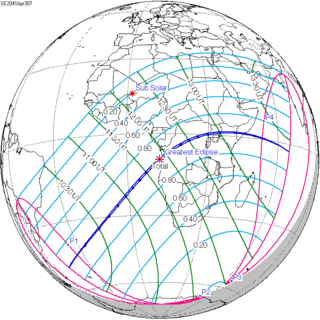
A total solar eclipse will occur on April 30, 2041. A solar eclipse occurs when the Moon passes between Earth and the Sun, thereby totally or partly obscuring the image of the Sun for a viewer on Earth. A total solar eclipse occurs when the Moon's apparent diameter is larger than the Sun's, blocking all direct sunlight, turning day into darkness. Totality occurs in a narrow path across Earth's surface, with the partial solar eclipse visible over a surrounding region thousands of kilometres wide.
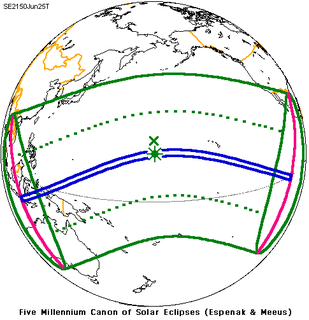
A total solar eclipse will occur on June 25, 2150. It will be the longest total eclipse since the 11th century. A solar eclipse occurs when the Moon passes between Earth and the Sun, thereby totally or partly obscuring the image of the Sun for a viewer on Earth. A total solar eclipse occurs when the Moon's apparent diameter is larger than the Sun's, blocking all direct sunlight, turning day into darkness. Totality occurs in a narrow path across Earth's surface, with the partial solar eclipse visible over a surrounding region thousands of kilometres wide.

A total solar eclipse will occur on July 5, 2168. A solar eclipse occurs when the Moon passes between Earth and the Sun, thereby totally or partly obscuring the image of the Sun for a viewer on Earth. A total solar eclipse occurs when the Moon's apparent diameter is larger than the Sun's, blocking all direct sunlight, turning day into darkness. Totality occurs in a narrow path across Earth's surface, with the partial solar eclipse visible over a surrounding region thousands of kilometres wide. Lasting a maximum of 7 minutes, 26 seconds, it will be the longest eclipse since the 11th century, which lasted 7 minutes and 20 seconds, as well with the next two occurrences. This is the largest total solar eclipse of Saros 139. Greatest Eclipse occurs 1,468 km north of the Equator.
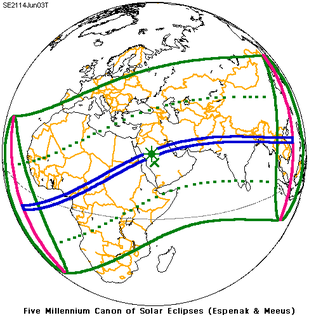
There will be a total solar eclipse on June 3, 2114. A solar eclipse occurs when the Moon passes between Earth and the Sun, thereby totally or partly obscuring the image of the Sun for a viewer on Earth. A total solar eclipse occurs when the Moon's apparent diameter is larger than the Sun's, blocking all direct sunlight, turning day into darkness. Totality occurs in a narrow path across Earth's surface, with the partial solar eclipse visible over a surrounding region thousands of kilometres wide.
